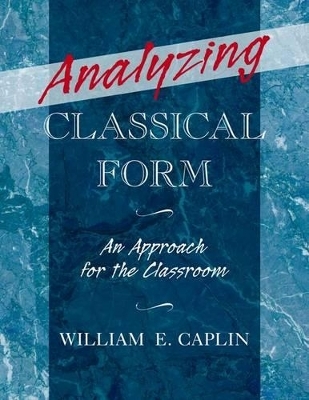
Analyzing Classical Form
Oxford University Press Inc (Verlag)
978-0-19-998729-0 (ISBN)
Analyzing Classical Form builds upon the foundations of the author's critically acclaimed Classical Form by offering an approach to the analysis of musical form that is especially suited for classroom use. Providing ample material for study in both undergraduate and graduate courses, Analyzing Classical Form presents the most up-to-date version of the author's "theory of formal functions." Students will learn how to make complete harmonic and formal analyses of music drawn from the instrumental works of Haydn, Mozart, and Beethoven. Part 1 introduces the principal theme-types of classical instrumental music; part 2 provides a methodology for analyzing sonata form, the most important formal type in this style period; and part 3 considers other full-movement forms found in this repertory (such as minuet, rondo, and concerto). The chapters are organized in a way that presents the most basic materials upfront and then leads the student through more details and finer points of theory. Every topic is illustrated with annotated musical examples; as well, the book contains many unannotated examples that can be used for in-class discussion and for out-of-class analytical exercises. A complete glossary of terms and questions for reviewing the theory will help students assimilate the many theoretical concepts employed in the book. A companion website provides audio and musical scores for all of the examples in the book as well as additional examples for the analysis of the simple theme-types presented in part 1.
William Caplin is James McGill Professor of Music Theory at the Schulich School of Music, McGill University, specializing in the theory of musical form and the history of harmonic and rhythmic theory in the modern era. A former president of the Society for Music Theory, he is currently a Killam Research Fellow writing a large-scale study on musical cadence.
Chapter 1 A Review of Harmony ; The Basics ; Harmonic vocabulary ; Harmonic progressions ; Let's Practice ; More Details ; Tonic function ; Dominant function ; Pre-dominant function ; Prolongational progressions ; Cadential progressions ; Sequential progressions ; Finer Points ; Reviewing the Theory ; Examples for Analysis ; Part 1 Conventional Theme-Types ; Chapter 2 The Sentence ; The Basics ; Presentation phrase ; Continuation phrase ; Let's Practice ; More Details ; Basic idea ; Repetition of the basic idea ; Tonic prolongation ; Presentation phrase versus presentation function ; Continuation function ; Cadential function ; Continuation ; Finer Points ; "Real" versus "notated" measures ; Modulating sentence ; Reviewing the Theory ; Examples for Analysis ; Model Composition ; Chapter 3 The Period ; The Basics ; Antecedent phrase ; Consequent phrase ; Let's Practice ; More Details ; Basic idea ; Contrasting idea ; Weak cadential closure ; Return of the basic idea ; Strong cadential closure ; Boundary processes: lead-in, elision ; Finer Points ; Antecedent (and consequent) as "mini-sentence" ; Modulating period; cadential strength ; Reinterpreted half cadence ; Sentence versus period ; Reviewing the Theory ; Examples for Analysis ; Model Composition ; Chapter 4 Hybrid Themes ; The Basics ; Hybrid types ; Let's Practice ; More Details ; Hybrid type: antecedent + continuation ; Hybrid type: antecedent + cadential ; Compound basic idea ; Hybrid type: compound basic idea + continuation ; Hybrid type: compound basic idea + consequent ; Finer Points ; Hybrid themes in relation to the sentence and period ; Appearances of the basic idea ; Phrase ambiguities ; Other "hybrid" possibilities ; Reviewing the Theory ; Examples for Analysis ; Model Composition ; Chapter 5 Phrase Deviations, Cadential Deviations, and Framing Functions ; The Basics ; Phrase deviations ; Cadential deviations ; Framing functions ; Let's Practice ; More Details ; Phrase deviations ; Cadential deviations ; Framing functions ; Finer Points ; Contrasting idea replaced by continuation phrase ; Codetta closes with cadence; cadence of limited scope ; Boundary process: melodic overlap ; Reviewing the Theory ; Examples for Analysis ; Model Composition ; Chapter 6 Compound Themes ; The Basics ; Compound Period ; Compound Sentence ; Let's Practice ; More Details ; Compound Period ; Compound Sentence ; Finer Points ; Compound period ; Real vs. notated measures ; Reviewing the Theory ; Examples for Analysis ; Model Composition ; Chapter 7 The Small Ternary (Rounded Binary) ; The Basics ; Exposition (A) ; Contrasting middle (B) ; Recapitulation (A') ; Let's Practice ; More Details ; Tight-knit versus loose formal organization ; Exposition (A) ; Contrasting middle (B) ; Recapitulation (A') ; Finer Points ; Contrasting middle (B) ; Recapitulation (A') ; Reviewing the Theory ; Examples for Analysis ; Model Composition ; Chapter 8 The Small Binary ; The Basics ; Part 1 ; Part 2 ; Let's Practice ; More Details ; Part 1 ; Part 2 ; Reviewing the Theory ; Examples for Analysis ; Model Composition ; Part 2 Sonata Form ; Chapter 9 Sonata Form-An Overview ; Large-scale formal structure ; Large-scale tonal structure ; Exposition ; Let's Practice ; Development ; Let's Practice ; Recapitulation ; Let's Practice ; Chapter 10 Exposition (I)-Main Theme ; The Basics ; More Details ; Conventional theme-types ; Nonconventional theme-types ; Finer Points ; Main-theme group ; Character and affect ; Reviewing the Theory ; Examples for Analysis ; Chapter 11 Exposition (II)-Transition ; The Basics ; Let's Practice ; More Details ; Style, character, dynamics ; Boundary processes: accompanimental overlap, elision ; Modulation techniques ; Opening strategies ; Phrase-structural organization; loosening devices ; Closure ; Finer Points ; Unusual opening strategies ; Two-part transition ; Omission of concluding function ; Reviewing the Theory ; Examples for Analysis ; Chapter 12 Exposition (III)-Subordinate Theme ; The Basics ; Let's Practice ; More Details ; Contrasting nature of the subordinate theme ; Looser sentential functions ; Internal half cadence (dominant arrival) ; Subordinate-theme group ; Closing section ; Finer Points ; Omission of initiating function ; Expanded periodic design ; Expanded repetition of a subordinate theme ; Harmonic-tonal loosening ; Thematic introduction ; Obscured boundary between transition and subordinate theme ; Reviewing the Theory ; Examples for Analysis ; Chapter 13 Development ; The Basics ; Tonal organization ; Phrase-structural organization ; Let's Practice ; More Details ; Melodic-motivic material ; Core ; Pre-core ; Retransition ; Finer Points ; Development sections without a core ; Transitional introduction ; Unusual endings ; Reviewing the Theory ; Examples for Analysis ; Chapter 14 Recapitulation ; The Basics ; An analytical methodology-comparison ; Tonal-harmonic organization ; Structural changes ; Let's Practice ; More Details ; Thematic functions of the recapitulation ; Structural changes: main theme ; Structural changes: transition ; Structural changes: subordinate theme (group) ; Finer Points ; Additional features of the recapitulation ; Fusion of main theme and transition ; Deviations from the norm ; Reviewing the Theory ; Examples for Analysis ; Chapter 15 Coda ; The Basics ; Let's Practice ; More Details ; Melodic-motivic material of the coda ; Start of the Coda ; Phrase structural organization of the coda ; Compensatory functions ; Reviewing the Theory ; Examples for Analysis ; Chapter 16 Slow Introduction ; The Basics ; Let's Practice ; More Details ; Style and affect ; Tonal, phrase-structural, and motivic organization ; Reviewing the Theory ; Examples for Analysis ; Part 3 Other Full-Movement Forms ; Chapter 17 Slow-Movement Forms ; The Basics ; Large Ternary ; Theme and Variations ; Sonata without development ; Let's Practice ; More Details ; Large ternary versus small ternary ; Large ternary-interior theme ; Large ternary-coda ; Theme and variations-structural alterations ; Finer Points ; Sonata form in slow movements ; Sonata without development-truncated recapitulation ; Ending a slow movement ; Reviewing the Theory ; Examples for Analysis ; Chapter 18 Minuet/Trio Form ; The Basics ; Minuet/trio form ; Minuet form ; Let's Practice ; More Details ; Exposition (A) ; Contrasting middle (B section) ; Recapitulation (A') ; Coda ; Trio ; Finer Points ; Binary minuet form ; Minuet/trio form-functional relations ; Reviewing the Theory ; Examples for Analysis ; Chapter 19 Rondo Forms ; The Basics ; Five-part rondo ; Sonata-rondo ; Let's Practice ; More Details ; Main theme ; Subordinate-theme complex ; Interior theme ; Returns of the main theme ; Development ; Coda ; Finer Points ; Deviations from the norm ; Enlargements of rondo form-seven-part rondo, nine-part sonata-rondo ; Reviewing the Theory ; Examples for Analysis ; Chapter 20 Concerto Form ; The Basics ; Opening ritornello ; Solo Exposition ; Subordinate-key ritornello ; Let's Practice ; More Details ; Opening ritornello ; Solo Exposition ; Subordinate-key ritornello ; Solo Development ; Solo Recapitulation ; Closing ritornello ; Reviewing the Theory ; Examples for Analysis ; Glossary of Terms ; Notes ; Index of Musical Compositions ; General Index
| Zusatzinfo | 430 music examples; 15 figures |
|---|---|
| Verlagsort | New York |
| Sprache | englisch |
| Maße | 216 x 278 mm |
| Gewicht | 1783 g |
| Themenwelt | Kunst / Musik / Theater ► Musik ► Instrumentenkunde |
| Kunst / Musik / Theater ► Musik ► Klassik / Oper / Musical | |
| Kunst / Musik / Theater ► Musik ► Musiktheorie / Musiklehre | |
| ISBN-10 | 0-19-998729-7 / 0199987297 |
| ISBN-13 | 978-0-19-998729-0 / 9780199987290 |
| Zustand | Neuware |
| Haben Sie eine Frage zum Produkt? |
aus dem Bereich


